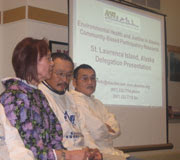1 T h e s s a l o n i a n s 4 : 1
Last Thursday, the Creation Care Committee attended the Women's board meeting to present on the topic of styrofoam. Our Savior's has, for many years, used styrofoam cups for the fellowship hour on Sunday mornings and has them available for use during the week as well. Styrofoam is also used on occasion for potlucks and community meals held in our building.
Vonnie Thordal, Co-President of the women's board, was enthusiastic and positive about adding the subject of styrofoam to their meeting agenda and we want to shout out a great big "Thank You!" to her her openness and willingness to consider another way!
Why is it important to stop using styrofoam?
Caring for the environment is part of our call to serve God and love our neighbor. A significant way we carry out that call is in the way we manage activities and functions on church grounds. This is easy to forget because our culture tells us it's our right to do what's easy and convenient. Christ tells us though, that it is our responsibility and vocation to honor God and the abundance He has given us.
Styrofoam is a bad deal
Styrofoam is a bad deal from beginning to end. Firstly, styrofoam is made from benzene, a known carcinogen, which is breathed in by the factory workers who often live lives of poverty which offer them little or no other choice for employment. The Benzene is converted to Styrene, polymerized and finally turned into foam by injecting gasses known to contribute to the destruction of the ozone layer and the production of smog. Benzene itself is made from oil and sometimes coal which is processed in plants which pump even more toxins and pollution into the air and ground and consume more oil to power the production process.
Secondly, there is no good way to recycle styrofoam. It is difficult to do and only a very few places do it. Furthermore, there are very few uses for recycled styrofoam and it is not suitable for making more cups. So recycling your cup does nothing to mitigate the need for more raw materials to make your next styrofoam cup.
Third. So styrofoam is made to be discarded and the damage to the environment is significant. According to the Recycler's Handbook, Americans send over 25 billion styrofoam cups to the landfill each year (and that's just the cups!). Consider Our Savior's: if 100 people drink coffee on Sunday mornings and use just one styrofoam cup, though some use more than one, times 52 weeks per year = 5,200 cups, they would use and throw away enough cups to fill 16 32 gallon trash cans. Then, the 5,200 cups are hauled away to the landfill in big, gas-guzzling trucks and dumped into the ground, where the chemicals leach into the ground and groundwater to become a problem for future generations.
Why is styrofoam still around if it's so bad?
Companies get away with it because they can. Styrofoam is cheap to make, cheap to ship and cheap to buy and they know if they put it on the shelves people will buy it. It's time for the Christian community to be the voice that says "No. This is not acceptable." We have to stop endorsing products that destroy what God gave us and charged us to protect.
There are several alternatives to styrofoam. The best and cheapest, of course, is to use ceramic mugs. One woman present at the meeting asked "how much would those cost?" and I was very happy to answer "nothing! We already own them and they're sitting in the cupboard downstairs in the kitchen!" Of course, using ceramic mugs requires the added time and effort of running the dishwasher as well as carting them upstairs to the Lounge on Sunday mornings and then back down again after the fellowship time is finished. We discussed the viability of asking the service unit volunteers who serve the coffee on Sundays to do this job or of finding someone who took on that task on a regular basis.
The next best thing would be biodegradable disposable cups - we still end up feeding the landfill but they would not be a toxic to God's creation and His people (factory workers!) as styrofoam. They are also thicker than paper cups and do well to hold hot liquids.
Yet another alternative is paper cups - though it was generally agreed at the meeting that those cups get pretty hot to hold.
Now what?
Though we did not reach a solid decision to discontinue stocking the church building with styrofoam cups, the women present at the meeting last Thursday were very gracious and open to learning more about the environmental issue around styrofoam and to the discussion of alternatives. Friends, this is where the process begins! And "Creation waits with eager longing..." (Romans 8:19).












